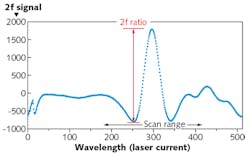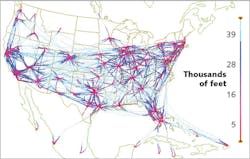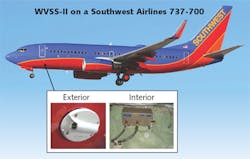Photonics Applied: Atmospheric Sensing: TDLAS atmospheric water vapor sensing improves weather forecasting
BRYCE L. FORD
Through aircraft-based meteorological observations, tunable diode laser absorption spectroscopy (TDLAS) technologies are being used to collect in situ observations from commercial aircraft, making a global contribution to advances in atmospheric sensing. The use of TDLAS technologies in the SpectraSensors Water Vapor Sensing System II (WVSS-II) provides atmospheric water vapor data for the international Aircraft Based Observations Program (ABOP), coordinated by the World Meteorological Organization (WMO).1, 2
Aviation, where dramatic changes in operating conditions are common, creates a challenging environment for the use of TDLAS in atmospheric sensing. Those challenges must be properly managed to achieve the high data quality necessary for meteorological applications and the long-term stability of autonomous operation necessary for use in aviation applications.
A 2f TDLAS overview
TDLAS implementations use a laser at a wavelength corresponding to an absorption line of the gas to be measured. As the laser is transmitted through the measurement sample, the detected laser power contains information on the gas density in the sample. The directly measured absorption relates to the gas density according to Beer-Lambert’s Law.
However, direct measurement spectroscopy is heavily impacted by noise sources often present in operational systems. To address this issue, a TDLAS approach using wavelength modulation spectroscopy (WMS) with second harmonic detection can be implemented. This approach eliminates the low-frequency noise sources, thus significantly improving the signal-to-noise ratio.
In a 2f configuration, the laser drive current is modulated as the laser is rapidly tuned across the absorption line or lines. A lock-in amplifier is used to detect the harmonic component of the signal at twice the modulation frequency (2f; see Fig. 1). The output of the 2f signal-processing step is directly proportional to the gas concentration (mixing ratio). This relative absorption measurement is insensitive to background noises impacting the signal and can be amplified to a greater extent than the direct absorption signal, enabling much greater sensitivity. This linearity of the 2f signal vs. gas concentration within a specified range is used for trace gas detection in various applications.
While the absolute signal strength may change for reasons other than gas concentration, the ratio of the 2f signal to the DC signal does not change. This reduces the sensitivity to uncontrollable variables in harsh operating conditions and minimizes impacts from other items such as variations in component performance.
The fundamentals of 2f TDLAS have been well documented in the literature for decades, with long-term sensor stability and high measurement quality being the cornerstone of numerous applications, especially atmospheric sensing in commercial aviation settings.3-5
Commercial aviation challenges for TDLAS
Water vapor measurement for the ABOP requires operation in conditions routinely experienced by commercial aircraft. On a typical flight, this includes the ascent of approximately 20 minutes where the atmospheric conditions—the gas to be measured—can change from water vapor concentrations of more than 40,000 parts per million by volume (ppmv) at the surface to under 50 ppmv at high-altitude flight levels.
During that same ascent period, the sensor experiences a change in air pressure from >1000 millibar (mb) to <200 mb, and a change in air temperatures from approximately +20°C to ≤-56°C. The sensor then experiences one or more hours at the very low temperature and pressure conditions at high altitudes (measuring low water vapor concentrations) before quickly descending through the atmosphere again to reach the surface conditions at the destination.
These extremely rapid changes in pressure and temperature conditions as well as the range of water vapor concentrations to be measured will commonly be experienced on five or more flights each day. With 2f TDLAS having dependencies on pressure and temperature, these operational extremes make the aviation environment a difficult one in which to sustain high-quality atmospheric measurements over a broad range of conditions.
Aviation environments also require fully automated operation with no crew input to the sensor of any kind. Other characteristics required for technology adoption in aviation include small size, low weight, low power, low aerodynamic drag, low icing risk, protections against high vibration and direct lightning strikes, and use of aviation standard protocols for data acquisition.
The sensor instrument must be resistant to impacts from the fumes, fuels, oils, detergents, deicers, and other contaminants commonly used in aviation, must maintain very high reliability of operation with extremely low maintenance, and should not require service of the sensor for calibration or any other reason more frequently than approximately every two years and preferably much less often. The design, production, and installation must also be certified for use in commercial aviation for each aircraft type on which it is installed and by each national or regional civil aviation authority in which it will operate. Indeed, the operational constraints required for aviation applications create considerable difficulties for TDLAS instrumentation that must be addressed in the manufacturing process.
To achieve the required performance and stability in the challenging conditions of aviation, WVSS-II uses a 1.37 µm laser corresponding to a selected absorption line of water vapor, a single-bounce optical path length of 22.7 cm, and a scan rate of 4 Hz. The implementation of thermal management and adaptive processing in the sensor design has undergone rigorous aviation certification testing and verification to ensure it preserves performance through the rapidly changing conditions experienced by commercial jet aircraft, achieving the measurement range of more than 40,000 ppmv to under 50 ppmv required for meteorological applications.
Air sample collection is accomplished via a patented technology that provides no drag, no icing risk, and no other negative impacts to aviation.6 Currently, the WVSS-II is certified for commercial aviation use on seven aircraft types and has achieved typical intervals of eight years or more between service of any kind.
In independent operational evaluations of WVSS-II performance, including intercomparisons with existing meteorological techniques, the WVSS-II enables water vapor detection at typical flight levels in the atmosphere, while maintaining the size, weight, power, and low-maintenance characteristics suitable for large-scale use on commercial aircraft fleets.7
Global meteorological contributions
Many National Meteorological and Hydrological Services (NMHS) from WMO Member nations, or regional associations of NMHSs, have implemented ABOP networks. These networks traditionally collect measurements of air temperature and pressure, wind speed, and wind direction taken from standard aircraft instrumentation. The combined data is transferred to the ground in near-real time through standard aviation datalink protocols for use in meteorological applications.
With more than 5000 aircraft reporting into the global ABOP network, a wealth of data is available for meteorological operations. However, these observations lack atmospheric water vapor data—a critical component in understanding the thermodynamics of the atmosphere.
With the addition of a WVSS-II sensor to the aircraft, water vapor measurements can be added to create a complete vertical profile of the atmosphere for use in all meteorological applications. The resulting data is comparable to that provided by conventional expendable sensors carried aloft by weather balloons. But with its long-term performance and low recurring cost of operations, ABOP with WVSS-II provides atmospheric water vapor sensing at a fraction of the long-term operational cost, improving global and regional weather forecasting.
At present, the U.S. operational network of aircraft equipped to measure water vapor with the WVSS-II totals 139—25 aircraft at UPS Airlines and 114 at Southwest Airlines, both in partnership with Rockwell Collins and the U.S. NOAA/National Weather Service (NWS).
For WVSS-II-equipped aircraft in the ABOP network, data is collected in near real-time and stored in meteorological database systems. Over a 24-hour period, this results in over 60,000 observations of the atmosphere in the U.S. (see Fig. 2). Each plotted point represents an individual atmospheric measurement sample with color representing the altitude of the measurement. In Europe, Lufthansa Airlines, in partnership with the German Weather Service Deutscher Wetterdienst (DWD), the E-AMDAR consortium, and Lufthansa Technik operates nine aircraft equipped with WVSS-II, with plans for further expansion.The global expansion of ABOP water vapor measurement is part of a new agreement between the WMO and the International Air Transport Association (IATA). Through WVSS-II, the use of TDLAS technologies allows worldwide in situ upper air meteorological observations, improving weather forecasting and exemplifying how advanced laser technologies provide societal benefits that improve our daily lives.
REFERENCES
1. See https://goo.gl/xeuxGp.
2. See www.wmo.int.
3. J. Reid and D. Labrie, Appl. Phys. B, 26, 203–210 (1981); https://goo.gl/g7EFot.
4. X. Liu, X. Zhou, and G. Sanger, “Wavelength-modulation absorption spectroscopy based trace moisture analyzer for natural gases,” The Instrumentation, Systems, and Automation Society, 52nd Analysis Division Symposium, 97 (Apr. 2007).
5. X. Liu et al., Appl. Phys. B, 82, 469 (2006).
6. Through license agreement with the University Corporation for Atmospheric Research Foundation.
7. R. A. Petersen et al., “On the Impact and Future Benefits of AMDAR Observations in Operational Forecasting: Part II: Water Vapor Observations,” Bulletin of the American Meteorological Society, 2117 (Nov. 2016).
8. See https://youtu.be/8alU5PMMXmo.
Bryce L. Ford is vice president of atmospheric programs at SpectraSensors, an Endress+Hauser Company, Houston, TX; e-mail: [email protected]; www.spectrasensors.com.


